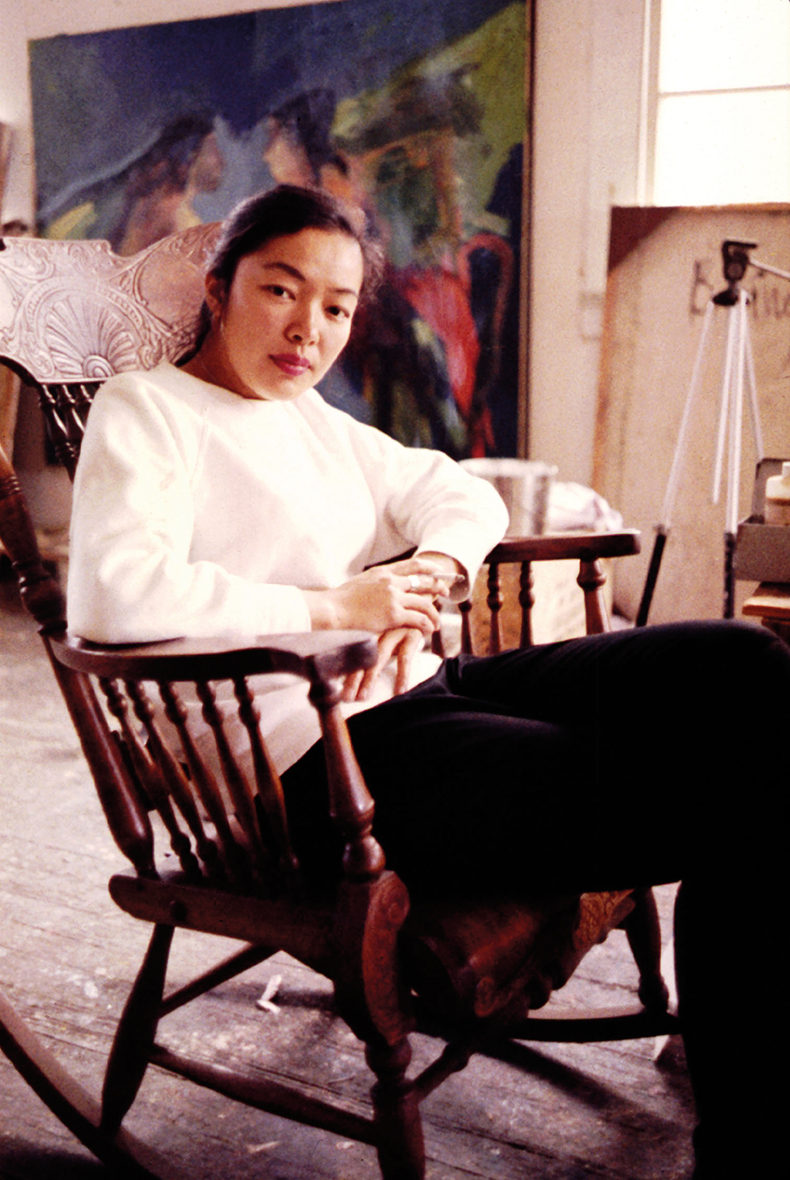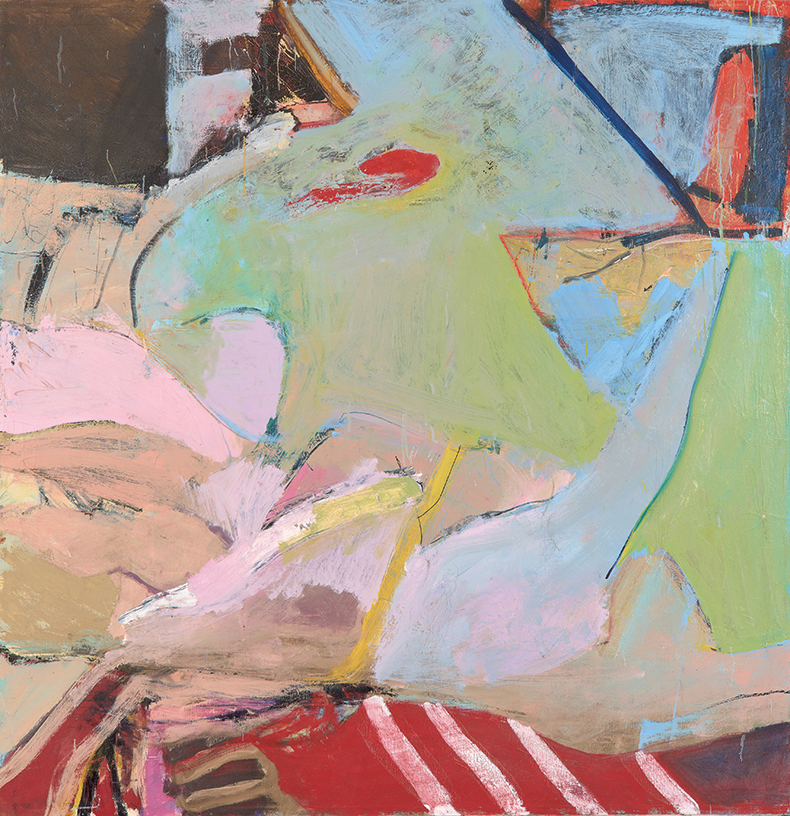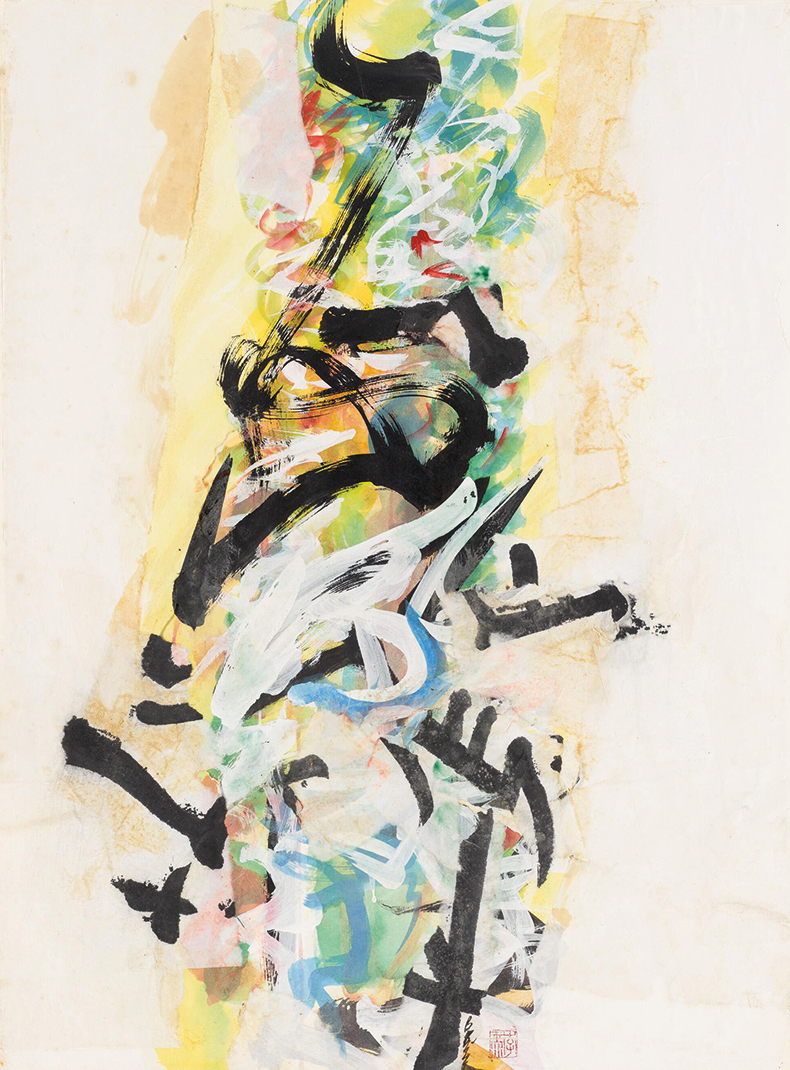From the October 2022 issue of Apollo. Preview and subscribe here.
Once upon a time, everybody knew Bingo. In San Francisco in the 1970s, it’s said she couldn’t walk down the street in North Beach or Chinatown without someone calling out her name. Bernice Bing, the statuesque artist known to most as Bingo, was easy to spot in her sharp zoot suits, boots and jet-black hair.
She was born in Chinatown in 1936; when it became the heart of the Beat movement in the 1950s, she found herself at the centre of a community that was not only wildly hedonistic but also close-knit, pluralistic, non-judgemental, socially progressive and spiritually visionary. Later, she worked with at-risk youth in the area, including gang members whom she persuaded to take part in art workshops. She helped found the South of Market Cultural Center (SOMAR, now known as SOMArts), which she ran in the 1980s. Why, then, is Bing – who died in 1998 – so little known today?

Bernice Bing (1936–98), photographed in her study in North Beach, San Francisco, in c. 1970. Photo: courtesy Estate of Bernice Bing
This month, the Asian Art Museum of San Francisco will introduce this important Chinese-American artist’s work to a generation perhaps only peripherally aware of her, if at all. An exhibition titled ‘Into View’ (7 October–1 May 2023) will bring to light the work of an unjustly forgotten artist while also examining the ways in which all aspects of her identity – not only her ethnicity but also her gender and sexuality – may have contributed to her marginalisation, both during her lifetime and after her death.
In 1957, the 21-year-old Bing enrolled at the California College of Arts and Crafts (CCAC), where she studied under the locally revered painters Richard Diebenkorn and Nathan Oliveira. But it was the Japanese artist Saburo Hasegawa who really captured the young Bing’s attention.
Bing’s peers, most of whom were white, probably blithely considered the kinship between their Asian teacher and his student somewhat inevitable. Hasegawa was a Japanese artist and critic who was among the earliest advocates for modern art in Japan. Before the Second World War he had travelled widely in the United States and Europe, returning to his native country with an evangelical belief in the importance of reviving traditional forms – especially ink painting and calligraphy – through Western modernist approaches. Later, he studied Zen and the practice came to suffuse his art. In class, Hasegawa wore long black traditional Zen robes and spoke to his students in gnomic metaphors, delivered in strongly accented English. Bing was entranced.
But Bing and Hasegawa were worlds apart. She was third-generation Chinese-American. While her stern grandmother spoke no English and had traditionally bound feet, Bing herself had never travelled to China. Her father died in jail; her abusive mother, who worked as a hat girl and waitress at the Forbidden City cabaret in San Francisco’s Chinatown, died of a heart condition when Bing was five. Bing spent her childhood in a string of mainly white foster homes, broken up by periods at the Ming Quong Home, an orphanage for Chinese girls, from which she once ran away. ‘I had no idea what it meant to be an Asian woman,’ she later recalled, of her time under Hasegawa’s tutelage. ‘He got me started thinking about that. I was in awe of him.’
Bing studied for only a few months at CCAC, transferring after her first semester to the California School of Fine Arts (which in 1960 became the San Francisco Art Institute; SFAI). Hasegawa died the same year, at the age of only 50, but the influence of the Japanese artist radiated throughout Bing’s life, like the ripples from a pebble thrown into a pond. ‘“To see without seeing” was a concept totally foreign to me,’ she later reflected. Zen became increasingly central to her thinking, even if art – or, more accurately, the art world – fluctuated in importance for her. ‘I am still burdened by the materialistic aspect of producing art,’ she admitted in her later years. ‘I haven’t learnt to let go of art […] How can I put it? It’s like the highest form of art becomes a vehicle, like a mantra.’

A Lady and a Road Map, (1962), Bernice Bing. Asian Art Museum of San Francisco. Photo: © Asian Art Museum of San Francisco; © Estate of Bernice Bing
Bing’s extant oeuvre – spanning from the late 1950s to the 1990s – is not the consistent, full and deep body of work that would have been the likely result of a hungry market and robust institutional support. Many important paintings have been lost, or were stolen, or have been destroyed. For some years in the 1980s Bing almost abandoned making art altogether, before returning to it with a renewed focus.
What endures from her life’s work is the testament of an artist attempting to navigate her unique circumstances, the obstacles and avenues of her subjectivity, her lived reality and her personal history. As a woman of colour, a lesbian, a survivor of abusive and inconstant foster care, a spiritual seeker and a bon vivant, she found kinship in San Francisco’s bohemian art scene. But her achievements were never raised up in the ways one might have expected, even if her community was not overtly prejudiced against her.
‘She was thriving at a time when multiculturalism was just starting to sprout on the West Coast with the Beat generation,’ says Abby Chen, curator of the AAM’s Bing survey. ‘She had a seat at the table but, gradually, she just got forgotten. And I think that has a lot to do with intersectionality.’
For sure, there were other female artists of her generation who were celebrated – some even during their lifetimes. Jay DeFeo, perhaps the most famous woman associated with the Beats, was seven years Bing’s senior; while Bing was still at college, DeFeo had enormous commercial success and was featured in a group exhibition at MoMA. Joan Brown, a friend and contemporary of Bing’s at the SFAI, invited Bing to accompany her in 1960 when she travelled to New York for her first commercial solo show and her inclusion in the exhibition ‘Young America 1960’ at the Whitney. (Brown’s concurrent, larger, posthumous retrospective runs at SFMOMA from 19 November–12 March 2023.) Deborah Remington, another older contemporary of Bing’s from college, was the only female founder of the Six Gallery in San Francisco, where Allen Ginsberg first read Howl.
Most narratives of this period will note that Remington was related to the famous Western painter Frederic Remington, and that DeFeo was married to the artist Wally Hedrick, and Brown was married to Manuel Neri. Whether these items of personal information are germane to an appreciation of these artists’ work is debatable, but it is revealing that the biographies of successful female artists are so often tethered to – as if qualified by – the biographies of male artists. Among the Abstract Expressionists, it has often been observed that many of the most successful female artists (including Elaine de Kooning, Lee Krasner and Helen Frankenthaler) had romantic relationships with even more successful male artists or critics. It is not to denigrate the hard-won achievements of these exceptional women to admit that, at that time, opportunities were more likely to drift your way if you happened to be standing close to one of the men on whom they were customarily showered. Such allegiances were not available to queer women, especially if they kept private their sexual orientation, as Bing did for most of her life.

Lotus/Lotus Sutra (1986), Bernice Bing. Asian Art Museum of San Francisco. Photo: © Asian Art Museum of San Francisco; © Estate of Bernice Bing
In 1960, while still a student, Bing was included in a 15-person group show at the Batman Gallery, an edgy new space on Fillmore Street with walls, floors and ceilings all painted entirely black. Among Beat luminaries such as Michael McClure, George Herms, Ray Johnson and Wally Hedrick, just three women were included, aside from Bing: Jay DeFeo, Joan Brown and Jean Linder. The exhibition’s title was ‘Gangbang’. Bing would go on, the following year, to have a solo show at Batman Gallery; her large-scale, gestural abstract paintings were regarded highly by her contemporaries. Nevertheless, the boorish and humiliating title of the earlier group exhibition says much about the politics at play in bohemian circles. Even though the Beat movement aspired (in theory) to inclusivity, in practice – like mainstream American culture at this time – it was dominated by (mostly white, mostly straight) men and by masculine sensibilities, camaraderie and humour, which played out in often damaging ways.
In the early 1990s, Bing looked back on her solo debut at Batman Gallery in 1961. ‘That show was a very impressive one, and people were somewhat surprised at my work because I hadn’t made a lot of noise at school. So, when I had that exhibition, people were rather taken aback by it.’ The exhibition included Diptych (1960), a two-panel painting eight feet tall by 12 feet wide, combining hard-edged, angular planes with dense, irregular knots that appear almost organic. The painting, which was later irreparably damaged, displayed Bing’s lifelong commitment to juxtaposition and synthesis; her inclination to chop and change, both in her paintings and in her life. In the San Francisco Chronicle, the critic Alfred Frankenstein enthused: ‘Bing […] has a remarkable gift for fluid line. […] Her paintings are huge and are most remarkable for the majestic sternness of their blacks and reds.’
Despite her early successes, San Francisco at the time did not have a sufficiently strong art market to support an emergent talent such as Bing. Artists who were living off their work (and there were few) tended to sell primarily in New York, as did Brown and DeFeo. It is not entirely clear why, in 1963, Bing upped sticks and took a job as caretaker of the Mayacamas Vineyards in the Napa Valley. When asked, she later explained, ‘After I left school, I needed to do something to support myself, and this job came up at the vineyards, and I thought, well I’ll just take a year off. But instead of taking a year, I took three years.’
The move was transformative. Bing’s appreciation of nature and landscape became a defining theme of her work. As a child she had sought refuge from her chaotic home life in the outdoors, and in adulthood it became a place to reflect, to look inward as well as out. ‘I wanted to concentrate not so much on images that would appear as landscape but rather to capture its ongoing changing dynamics of light,’ she later said. ‘The impact of this on masses and shadows produces a pictorial mode which gives you a sense of the overpowering spirituality that one feels when one is in a natural environment.’

Epilogue (1990–95), Bernice Bing. Asian Art Museum of San Francisco. Photo: © Asian Art Museum of San Francisco; © Estate of Bernice Bing
Diebenkorn – who taught at both CCAC and SFAI – was an obvious influence on Bing, both in his abstract canvases from the early 1950s and in his later compositions that compressed representations of space – and place – into flattened abstractions that sometimes also sheltered human protagonists. In Bing’s A Lady and a Road Map (1962), space recedes from the bottom to the top of the canvas, as in a conventional landscape. It is not clear, however, where the map ends and real space begins, nor where the lady’s body dissolves into our own (or the painter’s) standing before the picture.
During her time in Mayacamas, Bing read the works of Carl Jung, and was particularly impressed by his autobiography Memories, Dreams, Reflections, which had just been published in English. When, in 1967, she learnt of a new artists’ residency programme at the Esalen Institute, the clifftop New Age retreat centre in Big Sur, she applied. For nine months at Esalen she was able to paint and, more importantly, to attend workshops with ‘all the greats’ (as she put it) of alternative philosophy and comparative religion, including the mythologist Joseph Campbell, the Zen teacher Alan Watts, the psychiatrist R.D. Laing, and Fritz Perls, pioneer of gestalt therapy. It was where she learnt to meditate, a practice she maintained throughout her life.
The only large-scale painting she made during her residency is Big Sur (1967), and it is also one of her best-known. A glowing red horizon line evokes the ocean just after sunset; in the crepuscular foreground, a great jagged rock points up towards the sky. Floating in the sky, like a ghost or an angel, is an evanescent human form. In the heart of the rock, concentric rings of impasto paint describe an opening – a cavern, perhaps, or a wound – that reveals a glowing core. The picture alludes to the parallel processes of self-abandon and psychological and spiritual excavation that Esalen facilitated and encouraged.
During the 1970s Bing became increasingly involved in local arts initiatives in San Francisco, including the inception of the Neighborhood Arts Program. Bing focused her energies on Chinatown’s pre-teen Wah Ching gang members, as well as founding the organisation SCRAP (Scroungers’ Center for Reusable Art Parts), a source for free, recycled art materials that is still in operation. Frustrated by the lack of infrastructural support that she herself had experienced as an artist, she helped set up the South of Market Cultural Center, an alternative arts venue, which provided exhibition and event space for artists. She was the centre’s first director, an all-consuming task which obliged her to furlough her artistic practice.
By 1984, Bing was looking for a route back to making art again. On a Fulbright scholarship, she embarked on a three-month trip to China, where she found herself for the first time among a majority of people who looked like her, even if she admitted that she was easily picked out as a foreigner. ‘I was ethnically Chinese, I wasn’t culturally Chinese,’ she said. During this trip she lectured on Abstract Expressionism and also – momentously – studied calligraphy and traditional landscape painting at the Zhejiang Art Academy in Hangzhou.
Bernice Bing, photographed in 1965 by an unknown photographer. Photo: courtesy the estate of Bernice Bing
In the 1980s, Bing shifted in her spiritual practices from Zen to Nichiren Buddhism, a branch of the religion that involves the recital of a chant venerating the sacred Lotus Sutra, believed to alleviate suffering. The practitioner typically performs the invocation in front of a statue or a vertical scroll called a gohonzon. Though paintings by Bing from this period – such as the vertically composed Lotus/Lotus Sutra (1986) – resembled those by the Abstract Expressionist artists she admired, they were in fact closer in function, especially in her later years, to gohonzon than to gallery paintings.
Bing was by no means the only artist in America to have incorporated Buddhist ideas into her work. Since the Second World War, a wave of (often fetishistic) interest in Japanese culture had swept the nation, and teachers such as Alan Watts and D.T. Suzuki had popularised Zen, influencing artists from Franz Kline to John Cage, as well as many of the Beats. For Bing, Buddhism offered not only a reconnection to her own Asian ethnicity but also – perhaps more significantly – a promised path to inner healing. While in later life Bing allied herself with groups such as the Asian American Women Artists’ Association (AAWAA) and established many friendships there, it is nevertheless dangerous to place too much interpretative emphasis on Bing’s identity as an Asian American artist. Japan is not China, even if classical Chinese forms – especially within Buddhism – have made a historical contribution to Japan’s culture. And, anyway, the branches of Buddhism Bing practised were largely adapted for a contemporary American audience. Buddhism’s teachings of mutual care, of self-reflection and the ability to rise above suffering were more profound influences on the artist than the religion’s aesthetic or nationalistic trappings.
On her return from China, Bing once again sought the solitude of the countryside, this time in Philo, a tiny town in Mendocino County, three hours north of San Francisco. She stayed in Philo until her death, painting in a dilapidated shed lent by a friend. The epic Epilogue (1990–95), some two metres high and seven metres across, was made in this setting; it was included in her retrospective exhibition at SOMAR in 1991, a crowning achievement, although afterwards she brought it back to her studio and worked on it intermittently for another four years. The piece, divided by crisp vertical lines, synthesises aspects of Bing’s art from across the arc of her career: here are the organic knots; there are the soft, bodily forms; here the ‘majestic’ blacks and reds; there the quasi-calligraphic scrolls.
Epilogue points to the disjuncture that dogged Bing’s fragmentary identity: the co-existence of incommensurable subjectivities, influences, histories; parallel ways of being and ways of seeing. Did Bing find a way to resolve these conflicts, or did they tear her apart? On the evidence of this cohesive painting, she finally managed to reconcile the separations in her selfhood, on canvas at least. On the evidence of her fragile legacy, however, she may have got there too late.
‘Into View: Bernice Bing’ is at the Asian Art Museum of San Francisco from 7 October–1 May 2023.
From the October 2022 issue of Apollo. Preview and subscribe here.














![Masterpiece [Re]discovery 2022. Photo: Ben Fisher Photography, courtesy of Masterpiece London](http://zephr.apollo-magazine.com/wp-content/uploads/2022/07/MPL2022_4263.jpg)
‘Like landscape, his objects seem to breathe’: Gordon Baldwin (1932–2025)